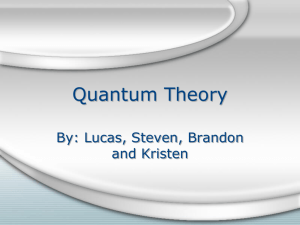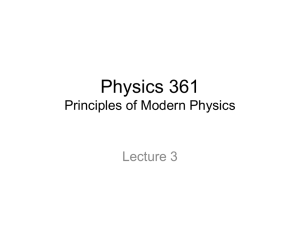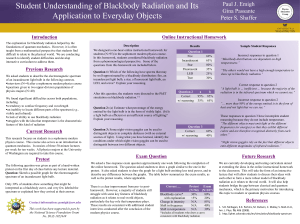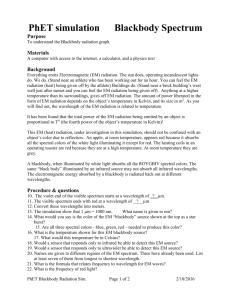Sources of radiation
advertisement
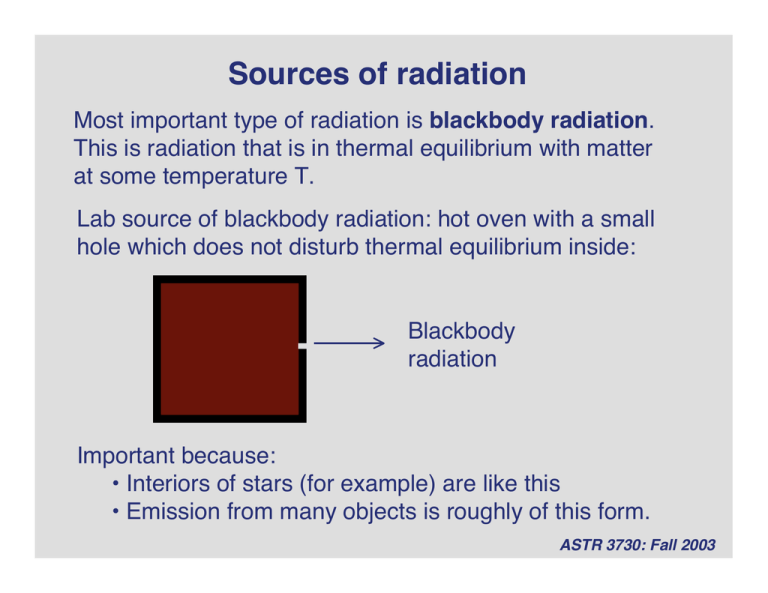
Sources of radiation Most important type of radiation is blackbody radiation. This is radiation that is in thermal equilibrium with matter at some temperature T. Lab source of blackbody radiation: hot oven with a small hole which does not disturb thermal equilibrium inside: Blackbody radiation Important because: • Interiors of stars (for example) are like this • Emission from many objects is roughly of this form. ASTR 3730: Fall 2003 A general principle in physics is that energy cannot flow spontaneously from a cold body to a hot one (a statement of the second law of thermodynamics). Implies that the intensity of blackbody radiation can only depend on T: T T In I n’ Imagine two blackbody cavities at the same temperature T, separated by a filter that transmits only radiation with frequency close to n. If: In ≠ In¢ …there would be a net energy flow, in violation of the 2nd law. Hence In can only depend on T. ASTR 3730: Fall 2003 † Spectrum of blackbody radiation The frequency dependence of blackbody radiation is given by the Planck function: 2hn 3 /c 2 Bn (T) = exp(hn /kT) -1 • h = 6.63 x 10-27 erg s is Planck’s constant • k = 1.38 x 10-16 erg K-1 is Boltzmann’s constant † Same units as specific intensity: erg s-1 cm-2 steradian-1 Hz-1 Derivation in Harwit, or see different derivation on the web page. ASTR 3730: Fall 2003 Properties of blackbody radiation Plot Bn(T): • Continuous spectrum • Increasing T increases Bn at all frequencies • Higher temperature shifts the peak to higher frequency / shorter wavelength. Thermal radiation: Sn = B n Blackbody radiation: In = Bn ASTR 3730: Fall 2003 Differentiate Bn(T) with respect to frequency and set resulting expression to zero to find where the Planck function peaks. hn max = 2.82kT n max = 5.88 ¥1010 T Hz K -1 Wien displacement law - peak shifts linearly with increasing temperature to higher frequency. † Rayleigh-Jeans law: for low frequencies hn << kT: 2 2 n BnRJ (T) = 2 kT c Often valid in the radio part of the spectrum, at frequencies far below the peak of the Planck function. † ASTR 3730: Fall 2003 The energy density of blackbody radiation: u(T) = aT 4 …where a = 7.56 x 10-15 erg cm-3 K-4 is the radiation constant. The emergent flux from a surface emitting blackbody radiation is:† F = sT 4 …where s = 5.67 x 10-5 erg cm-2 K-4 s-1 is the StefanBoltzmann constant. † e.g. star, radius R, temperature T, emitting as a blackbody, has a luminosity: L = 4pR 2sT 4 ASTR 3730: Fall 2003 † Emission from most astronomical sources is only roughly described by the Planck function (if at all). Source has emergent flux F (integrated over all frequencies), define the effective temperature Te via: F ≡ sTe4 Effective temperature is the temperature of a blackbody that emits same flux. e.g. for the Sun: † 2 Lsun = 4 pRsun sTe4 …find Te = 5770 K. Note: effective † temperature is well-defined even if the spectrum is nothing like a blackbody. ASTR 3730: Fall 2003 Which objects have blackbody spectra? Radiation will be blackbody radiation wherever we have matter in thermal equilibrium with radiation - i.e. at large optical depth. To show this, consider transfer equation with Sn = Bn(T), and assume T is constant: dIn = -In + Bn (T) dt n Can integrate this equation, with solution: † In (t ) = Bn + e-t [ I0 - Bn ] -> 0 as t becomes large where I0 is the value of In at t = 0. Conclude In = Bn at high † optical depth, e.g. in the center of a star. ASTR 3730: Fall 2003 Recall interpretation of optical depth: at t = 1 there is (very roughly speaking) a 50% chance that a photon headed toward us will suffer an absorption or scattering along the way. By definition, photons we can observe from an optically thick source come from near the t = 1 surface. Since t = 1 is not `high optical depth’, observed radiation from an optically thick source is not necessarily blackbody spectrum. Deviations will depend upon the frequency dependence of the opacity around the t = 1 surface (the photosphere). ASTR 3730: Fall 2003 Solar spectrum - approximately of blackbody form. Very cool stars show larger departures from thermal spectra. flux wavelength ASTR 3730: Fall 2003 Giant planets Two sources of radiation: • Directly reflected Sun light • Absorbed Solar radiation, reradiated as a cool blackbody e.g. Jupiter: Lsun = 3.86 ¥10 33 erg s-1 aJ = 7.8 ¥1013 cm R J = 7.1¥10 9 cm Jupiter orbital radius Jupiter radius Solar radiation incident on the planet is: † pRJ2 -9 LJ = ¥ L ª 2 ¥10 Lsun sun 2 4paJ Suppose planet directly reflects 10% - in the optical Jupiter is ~1010 times fainter than the Sun as seen from another star -†about 25 magnitudes. ASTR 3730: Fall 2003 Absorb and reradiate as a blackbody: 2 J 4 J LJ = 4pR ¥ sT If all Sun light absorbed, estimate T = 120 K. Use: hn max = 2.82kT Find nmax† = 7 x 1012 Hz, which corresponds to a wavelength of around 40 microns. † ASTR 3730: Fall 2003
